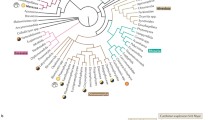Abstract.
Models for the origin of the sex incorporate either obligate or facultative sexual cycles. The relevance of each assumption to the ancestral sexual population can be examined by surveying the sexual cycles of eukaryotes, and by determining the first lineage to diverge after sexuality evolved. Two protistan groups, the parabasalids and the oxymonads, have been suggested to be early-branching sexual lineages. A maximum-likelihood analysis of elongation factor-1α sequences shows that the parabasalids diverged prior to the oxymonads and thus represent the earliest sexual lineage of eukaryotes. Since both of these protist lineages and most other eukaryotes are facultatively sexual, it is likely that the common ancestor of all known eukaryotes was facultatively sexual as well. This finding has important implications for the ``Best-Man hypothesis'' and other models for the origin of sex.
Similar content being viewed by others
Author information
Authors and Affiliations
Additional information
Received: 21 August 1998 / Accepted: 26 December 1998
Rights and permissions
About this article
Cite this article
Dacks, J., Roger, A. The First Sexual Lineage and the Relevance of Facultative Sex. J Mol Evol 48, 779–783 (1999). https://doi.org/10.1007/PL00013156
Issue Date:
DOI: https://doi.org/10.1007/PL00013156




